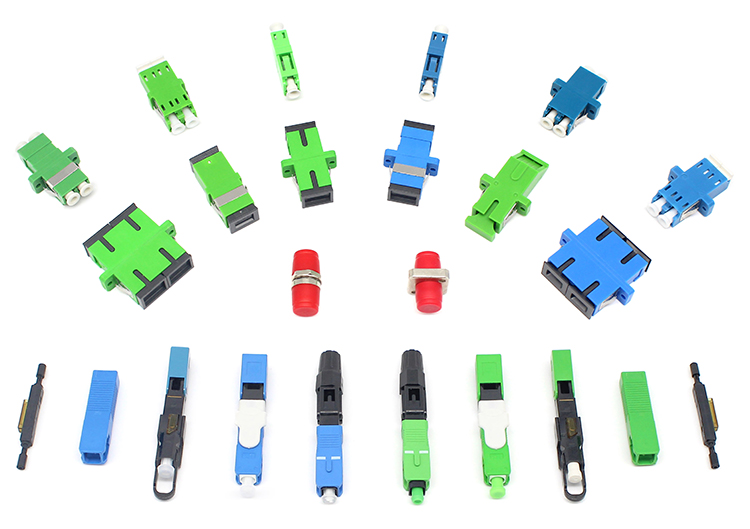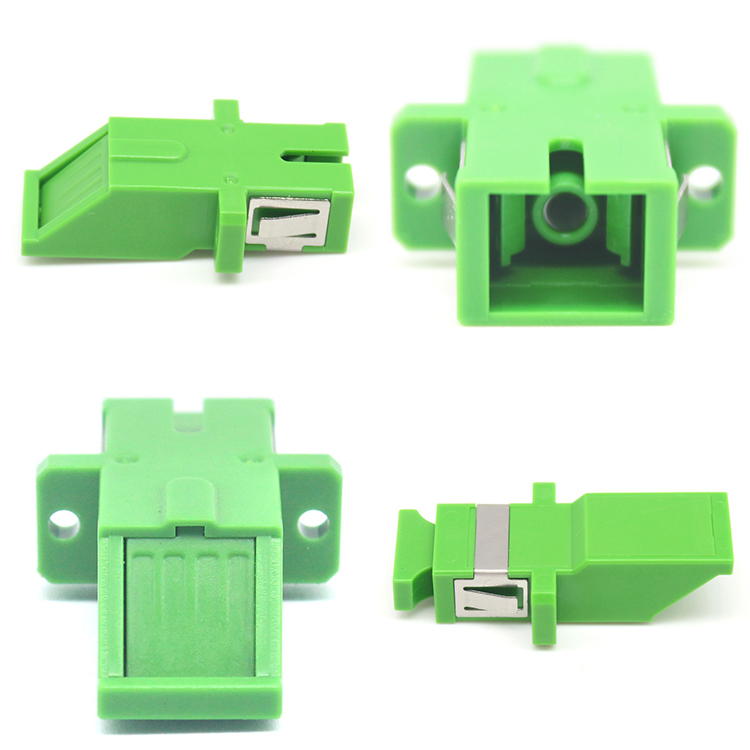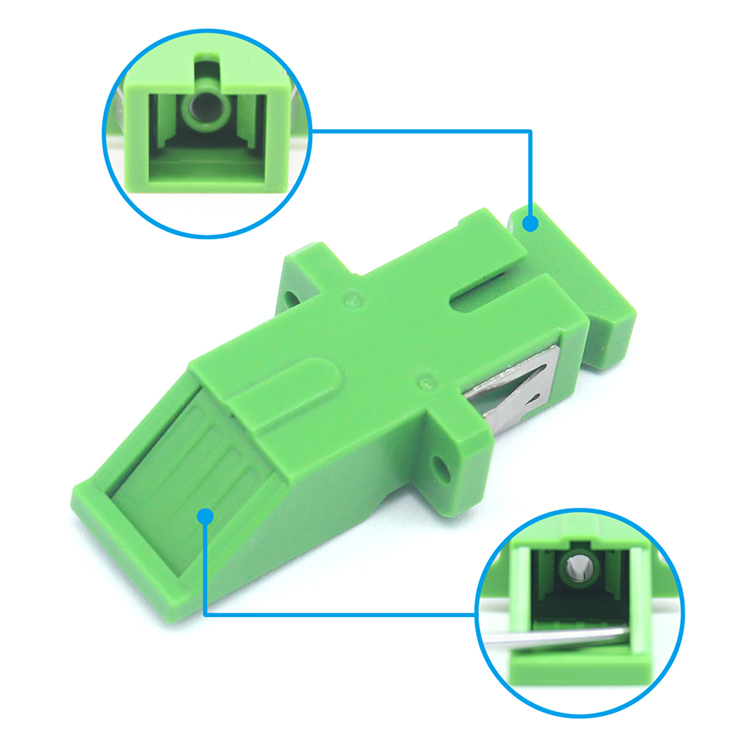
SC/APC adapters play a pivotal role in fiber optic networks. These SC APC adapters, also known as fiber connector adapters, ensure precise alignment, minimizing signal loss and optimizing performance. With return losses of at least 26 dB for singlemode fibers and attenuation losses below 0.75 dB, they are indispensable in data centers, cloud computing, and other high-speed environments. Additionally, the SC UPC adapter and SC Simplex adapter variants offer further options for various applications, enhancing the versatility of fiber optic adapters in modern communication systems.
Key Takeaways
- SC/APC adapters help reduce signal loss in fiber networks.
- They are important for fast and reliable data transfer.
- The angled shape of SC/APC adapters lowers signal reflection.
- This gives them better signal quality than SC/UPC connectors.
- Cleaning them often and following rules keeps them working well.
- This is especially important in tough and busy environments.
Understanding SC/APC Adapters

Design and Construction of SC/APC Adapters
SC/APC adapters are meticulously designed to ensure precise alignment and secure connections in fiber optic networks. These adapters feature a green-colored housing, which distinguishes them from other types like SC/UPC adapters. The green color indicates the use of an angled physical contact (APC) polish on the fiber end face. This angled design, typically at an 8-degree angle, minimizes back reflections by directing light away from the source.
The construction of SC/APC adapters involves high-quality materials such as zirconia ceramic sleeves. These sleeves provide excellent durability and ensure accurate alignment of the fiber cores. The adapters also include robust plastic or metal housings, which protect the internal components and enhance their longevity. The precision engineering of these adapters ensures low insertion loss and high return loss, making them ideal for high-performance fiber optic networks.
How SC/APC Adapters Work in High-Speed Networks
SC/APC adapters play a critical role in maintaining the efficiency of high-speed networks. They connect two fiber optic cables, ensuring that the light signals pass through with minimal loss. The angled end face of the SC/APC adapter reduces signal reflection, which is crucial for maintaining the integrity of data transmission over long distances.
In modern fiber optic infrastructures, single-mode networks rely heavily on SC/APC adapters. These networks are designed for long-distance transmission and high bandwidth, making the low insertion loss and high return loss characteristics of SC/APC adapters essential. By minimizing signal degradation, these adapters ensure optimal data transfer speeds, which are vital for applications like data centers, cloud computing, and virtualized services.
The reliability of SC/APC adapters stems from their use of high-quality materials and precision engineering. This reliability is crucial for maintaining high-performance connections in environments where even minor signal losses can lead to significant disruptions. As a result, SC/APC adapters have become indispensable components in the development of modern, high-speed fiber optic networks.
Benefits of SC/APC Adapters in Fiber Optic Networks

Comparison with UPC and PC Connectors
SC/APC adapters offer distinct advantages over UPC (Ultra Physical Contact) and PC (Physical Contact) connectors, making them the preferred choice for high-performance fiber optic networks. The key difference lies in the geometry of the connector end face. While UPC connectors feature a flat, polished surface, SC/APC adapters utilize an 8-degree angled end face. This angled design minimizes back reflection by directing reflected light into the cladding rather than back toward the source.
The performance metrics further highlight the superiority of SC/APC adapters. UPC connectors typically achieve a return loss of around -55 dB, whereas SC/APC adapters deliver a return loss exceeding -65 dB. This higher return loss ensures better signal integrity, making SC/APC adapters ideal for applications like FTTx (Fiber to the x) and WDM (Wavelength Division Multiplexing) systems. In contrast, UPC connectors are more suited for Ethernet networks, where return loss is less critical. PC connectors, with a return loss of approximately -40 dB, are generally used in less demanding environments.
The choice between these connectors depends on the specific requirements of the network. For high-bandwidth, long-haul, or RF video signal transmission applications, SC/APC adapters provide unmatched performance. Their ability to reduce reflection and maintain signal quality makes them indispensable in modern fiber optic infrastructures.
Low Optical Loss and High Return Loss
SC/APC adapters excel in ensuring low optical loss and high return loss, two critical factors for efficient data transmission. The low insertion loss of these adapters ensures that a significant portion of the original signal reaches its destination, minimizing power losses during transmission. This characteristic is particularly important for long-distance connections, where signal attenuation can compromise network performance.
The high return loss capabilities of SC/APC adapters further enhance their appeal. By absorbing reflected light into the cladding, the 8-degree angled end face significantly reduces back-reflection. This design feature not only improves signal quality but also minimizes interference, which is crucial for maintaining the integrity of high-speed data transmission. Laboratory tests have demonstrated the superior performance of SC/APC adapters, with insertion loss values typically around 1.25 dB and return loss exceeding -50 dB.
These performance metrics underscore the reliability of SC/APC adapters in demanding environments. Their ability to maintain low optical loss and high return loss makes them a cornerstone of high-speed networks, ensuring seamless data transfer and reduced downtime.
Applications in High-Density and Critical Network Environments
SC/APC adapters are indispensable in high-density and critical network environments, where performance and reliability are paramount. Data centers, cloud computing infrastructures, and virtualized services rely heavily on these adapters to maintain optimal network performance. Their low insertion loss and high return loss characteristics make them ideal for high-bandwidth applications, ensuring efficient data transmission even in densely packed network setups.
In FTTx deployments, SC/APC adapters play a vital role in delivering high-speed internet to end users. Their ability to minimize signal degradation and back-reflection ensures consistent performance, even in networks with multiple connection points. Similarly, in WDM systems, these adapters support the transmission of multiple wavelengths over a single fiber, maximizing bandwidth utilization and reducing infrastructure costs.
The versatility of SC/APC adapters extends to passive optical networks (PONs) and RF video signal transmission. Their superior performance metrics make them suitable for applications where even minor signal losses can have significant consequences. By ensuring reliable and efficient connections, SC/APC adapters contribute to the seamless operation of critical network environments.
Practical Considerations for SC/APC Adapters
Installation and Maintenance Guidelines
Proper installation and maintenance of SC/APC adapters are essential for ensuring optimal performance in fiber optic networks. Technicians should follow industry-recognized guidelines to minimize signal loss and maintain network reliability. Cleaning and inspection play a critical role in this process. Dust or debris on the adapter’s end face can cause significant signal degradation. Using specialized cleaning tools, such as lint-free wipes and isopropyl alcohol, ensures the adapter remains free of contaminants.
The following table outlines key standards that provide guidance on installation and maintenance practices:
| Standard | Description |
|---|---|
| ISO/IEC 14763-3 | Offers detailed guidelines for fiber testing, including SC/APC adapter maintenance. |
| ISO/IEC 11801:2010 | Refers users to ISO/IEC 14763-3 for comprehensive fiber testing protocols. |
| Cleaning Requirements | Highlights the importance of regular cleaning and inspection for performance. |
Adhering to these standards ensures that SC/APC adapters deliver consistent performance in high-speed networks.
Compatibility with Industry Standards
SC/APC adapters must comply with established industry standards to guarantee seamless integration into diverse network environments. Compliance with these standards ensures that the adapters meet performance, safety, and environmental requirements. For example, Category 5e standards validate network performance, while UL standards confirm adherence to safety protocols. Additionally, RoHS compliance ensures that the materials used in the adapters meet environmental regulations.
The table below summarizes key compliance standards:
| Compliance Standard | Description |
|---|---|
| Category 5e | Ensures compatibility with high-performance network systems. |
| UL Standard | Verifies compliance with safety and reliability requirements. |
| RoHS Compliance | Confirms adherence to environmental material restrictions. |
By meeting these standards, SC/APC adapters remain a reliable choice for modern fiber optic networks.
Real-World Performance Metrics
SC/APC adapters consistently demonstrate superior performance in real-world applications. Their low insertion loss, typically below 0.75 dB, ensures efficient signal transmission over long distances. High return loss, often exceeding -65 dB, minimizes back-reflection, which is critical for maintaining data integrity in high-speed networks. These metrics make SC/APC adapters indispensable in environments like data centers and FTTx deployments.
Field tests have shown that SC/APC adapters maintain their performance even under challenging conditions. Their robust construction and adherence to industry standards contribute to their reliability. This makes them a preferred choice for applications requiring high bandwidth and minimal signal degradation.
SC/APC adapters deliver exceptional performance by ensuring low optical loss and high return loss, making them indispensable for high-speed networks. Their ability to maintain signal integrity supports the scalability and reliability of modern infrastructures. Dowell offers high-quality SC/APC adapters designed to meet the demands of evolving network environments. Explore their solutions to future-proof your connectivity needs.
Author: Eric, Manager of the Foreign Trade Department at Dowell. Connect on Facebook: Dowell Facebook Profile.
FAQ
What distinguishes SC/APC adapters from SC/UPC adapters?
SC/APC adapters feature an angled end face that reduces back reflection. SC/UPC adapters have a flat end face, making them less effective for high-speed networks.
How should SC/APC adapters be cleaned?
Use lint-free wipes and isopropyl alcohol to clean the end face. Regular cleaning prevents signal degradation and ensures optimal performance in fiber optic networks.
Are SC/APC adapters compatible with all fiber optic systems?
SC/APC adapters comply with industry standards like ISO/IEC 14763-3, ensuring compatibility with most fiber optic systems, including single-mode and high-bandwidth applications.
Post time: May-19-2025
